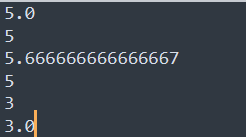Python 变量和简单数据类型 2
1. print 打印
print("Hello Python world!")
2.变量
message = "Hello Python world!" print(message)
3.字符串 可以是单引号也可以是双引号
"This is a string." 'This is also a string.'
4.字符串大小写转换
name = "Ada Lovelace" print(name.upper()) print(name.lower())
5.字符串中使用变量 f代表format
first_name = "ada" last_name = "lovelace" full_name = f"{first_name} {last_name}" print(full_name)
6.字符串中添加制表符,可使用字符串组合\t
c="\tabc" print (c)

7.字符串 换行使用\t
print("Languages:\n\tPython\n\tC\n\tJavaScript")

8.字符串去空白(依次是去右边,去左边,去两边)
favorite_language=' pyhton ' str1=favorite_language.rstrip() print(str1) str2=favorite_language.lstrip() print(str2) str3=favorite_language.strip() print(str3)
9. 整数
# 整数 a=2; b=3 print(a+b) #整数没有限制大小 a=11121212132123123123223423423423423432423 b=23423423423423423423423423423423423423423 print(a+b) #转整数 c="23" d="23" print(int(c)+int(d))

10.浮点数
#浮点数 a=0.2; b=0.1 print(a+b) #转浮点数 c="1212.12" d="1212.12" e=float(c)+float(d) print(e)

11.常量
在高级语言中,常量类似于变量,但值在程序整个生命周期内保持不变, python是没有内置的常量类型,但开发时可能需要, 定义常量时,约定变量名用大写视为常量,当开发人员看到大写的变量时,就不去重新赋值,这是一种约定。
MAX_CONNECTIONS=5000
print(MAX_CONNECTIONS)
12.数字下划线
#数字下划线,更好的可读性,python3.6+支持 universe_age=14_000_000_000 print(universe_age) 输出 14000000000
13.除法运算符 / 和 // 介绍
#除法/总是返回一个浮点数,如果只想要整数,使用运算符// a=10; b=2 print(a/b) print(a//b) #整数除法返回浮点型 print(17/3) #返回整数 print(17//3) #注意使用 //运算符时, 只有整数与整数运算才能返回整数,否则返回浮点数 print(7//2) print(7.0//2) print(7//2.0)

14.bool 布尔类型
a=True b=False if a!=b: print('不相等') else: print('相等')

15.字符串截取
下面一段代码是截取token值
body='"hello": getSearchToken("1","6jQFmiGx9FOZ2iubiELVukGjhtiqN5aPA468wlEcaVrD9IUdZ4"),' start=body.find('getSearchToken') if start==-1: print('未找到getSearchToken!') start+=20 end=start+53 newbody=body[start:end].replace('"),','') print(newbody)

分类:
Python 基础



【推荐】国内首个AI IDE,深度理解中文开发场景,立即下载体验Trae
【推荐】编程新体验,更懂你的AI,立即体验豆包MarsCode编程助手
【推荐】抖音旗下AI助手豆包,你的智能百科全书,全免费不限次数
【推荐】轻量又高性能的 SSH 工具 IShell:AI 加持,快人一步
· 无需6万激活码!GitHub神秘组织3小时极速复刻Manus,手把手教你使用OpenManus搭建本
· C#/.NET/.NET Core优秀项目和框架2025年2月简报
· Manus爆火,是硬核还是营销?
· 一文读懂知识蒸馏
· 终于写完轮子一部分:tcp代理 了,记录一下
2018-08-04 mysql 开发进阶篇系列 14 锁问题(避免死锁,死锁查看分析)